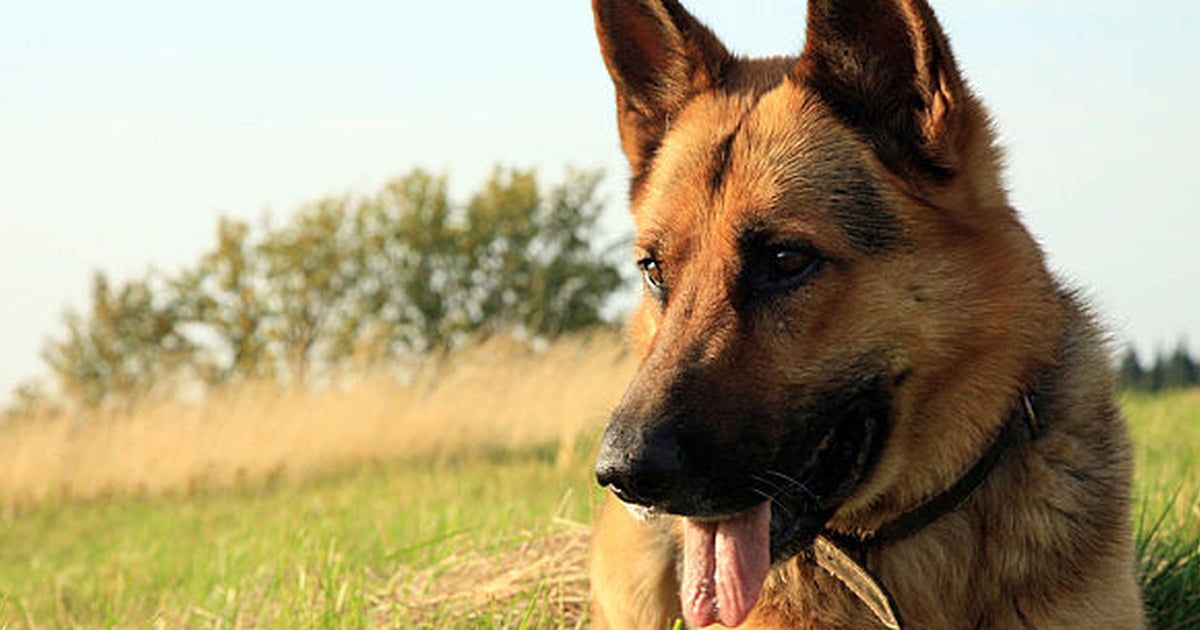What Exactly Is Hip Dysplasia In German Shepherds
Hip Dysplasia is a joint condition frequently seen in large dogs such as the German Shepherd. It is seen in smaller dog breeds but not as often. It is caused by an improper fitting of the ball and hip socket. The result is a wearing down of the joint over time which leads to mobility issues down the road. Often times dogs must use a wheelchair to assists the back legs when walking. Supplements can help but in some cases, hip replacement surgeries are necessary.
How Do You Tell Your German Shepherd You Love Them
A moderate exercise will promote the muscle development necessary for joint stability but without overloading the joint. Regular visits to the vet for general check- ups, especially to check the condition of the joints and their development. In conclusion, we now know how to prevent hip dysplasia in German Shepherds.
What Causes A German Shepherd To Be Put Down
The most common reasons German Shepherds are put down are musculoskeletal disorders and an inability to stand. One of the most common problems these dogs face which cause both of those is hip dysplasia. Although its not always preventable, there are things you can do to keep your pet from becoming another statistic.
Also Check: How To Stop German Shepherd Aggression
Summary: How Long Can A Dog Live With Hip Dysplasia
If youre buying a large breed puppy, theres a good chance hell be prone to hip dysplasia.
But, even some small breeds like the French Bulldog and the Pug may need a hip evaluation.
You may want a breed whos prone to hip dysplasia. But only buy from breeders who prove the parents have low hip scores.
Managing weight and exercise is also crucial.
If your puppy has any symptoms, get your vet to check them straight away.
How long do dogs live with hip dysplasia?
With fast detection and good care, they can live a long time.
German Shepherd Build And Temperament

German Shepherds have been bred to be the way that they are today. That means that there are certain things that the original breeders hoped to develop with this particular type of dog. The most common characteristics that German Shepherds are revered for include:
- Being strong. German Shepherds are quite strong and are capable of handling physically demanding tasks. Their fur and their bodies also allow them to be relatively comfortable even in unpleasant environments. Which makes have good joints and bone structure essential.
- Being intelligent. German Shepherds are among the smartest dog breeds and can be taught to perform fairly complicated tasks. Training them, thanks to their intelligence and their need for mental stimulation, can be quite fun and rewarding.
- Having a good temperament. While Shepherds will certainly become aggressive if they are protecting their owners, the rest of the time they are known for being quite calm and happy. This makes them good for families.
- Being energetic. Some people might not consider this a positive trait, because Shepherds need to have ample exercise time every day. If not, theyll begin to find other outlets for their energy, not all of which are pleasant for their owners!
In addition to that, shepherds have a natural drive to be productive. They like making their owners happy and take pride in being able to do a job well done.
Don’t Miss: Are All German Shepherds Born Black
How Long Can A Dog Live With Hip Dysplasia
The good news about hip dysplasia is that dogs can continue to live a long, happy life. If you think your dog may have hip dysplasia, taking them to the vet for a diagnosis as soon as you can is vital. Once your dog has been diagnosed, make sure you talk to your vet about potential treatment options, including medication and surgery. With the right treatment, dogs with hip dysplasia can live a long life with minimal pain and discomfort.1
First Signs Of Hip Dysplasia And What You Need To Do
One health condition that all German shepherd owners need to be aware of is hip dysplasia. Some German shepherds are genetically prone to this crippling condition, however, it is possible for all breeds of dogs to be effected.
Both small and large dogs can suffer from hip dysplasia, despite it being more common in large or giant breeds such as German shepherds, Labrador Retrievers, Saint Bernards, and Great Danes.
Responsible breeders wont breed dogs with canine hip dysplasia and some will perform genetic tests on their dogs to reduce the genetic risk. However, there are additional factors at play that increase the odds of dogs genetically predisposed to developing CHD.
Along with genetics, nutrition, excessive growth, some types of exercise, and being overweight can all contribute to a dog developing hip dysplasia, which can show up in dogs as young as four months old.
What is canine hip dysplasia ?
According to the American College of Veterinary Surgeons, CHD is:
a condition that begins in dogs as they grow and results in instability or a loose fit of the hip joint. The hip joint laxity is responsible for potential clinical signs of hip pain and limb dysfunction and progressive joint changes.
What are the symptoms of Canine Hip Dysplasia?
Every German shepherd owner should be aware of the signs and symptoms of CHD so they can get appropriate care for their pet as soon as possible. The symptoms of CHD include:
How is canine hip dysplasia diagnosed?
Prevention:
Also Check: Are German Shepherds Born Black
German Shepherd Hip Dysplasia Treatment Options
The treatment of canine hip dysplasia is a complex field, but there are several options available to those with the disorder. Some of the more common treatments include surgery, medications, and physical therapy.
German Shepherd Hip Dysplasia surgery for severe cases in medium to large dogs can be costly and can cost between $1,000 and $3,000 per hip.
Total Hip Replacement is the most expensive, costing between $3,500 and $7,500. If invasive surgery is not the best option for your dog, consider non-surgical, conservative management options such as dog leg braces, physical therapy, weight control, acupuncture, anti-inflammatories, and massage therapy.
What Happens If Hip Dysplasia Is Left Untreated
Hip dysplasia is a treatable condition. However, if left untreated, it can cause irreversible damage that will cause pain and loss of function later in life. It is the leading cause of early arthritis of the hip before the age of 60. The severity of the condition and catching it late increase the risk of arthritis.
You May Like: What Will My German Shepherd Look Like
Symptoms And Diagnosis Of Hip Dysplasia
German Shepherd hip dysplasia is often present at birth. However, the symptoms are not always apparent at a young age and may not show until 9 to 12 months of age.
You will then notice the clinical signs in the previous discussion. Your puppy or adult German Shepherd may also snap at you because it is in pain.
Signs of hip dysplasia may also appear in adult or mature years, and the severity can vary between animals.
This conditions severity is reliant on the dogs activity levels. The joint degradation rapidly increases with more significant activity, which stresses the joints.
If the hip dysplasia is mild, the chances are that this condition will deteriorate slowly. The opposite is also true when the hip dysplasia is severe, in which case joint degradation speeds up.
Luckily, only a tiny percentage of this breed will develop an acute form of this disease, which is crippling.
While a puppys parents may not have dysplasia, they can still inherit this disease. Vets warn that environmental circumstances also play a role in its development.
Therefore, it is vital to manage elements such as your pets weight, activity, lifestyle, and nutrition to provide your pet with the best care possible.
If you doubt whether your German Shepherd. An expert diagnosis helps create a plan to improve their quality of life
A professional test helps breeders know which dogs are suitable for breeding and aids pet owners with the future management of their pets health.
Which Breeds Are More Prone To Developing Hip Dysplasia
Any type of dog can develop hip dysplasia, but it is typically seen in medium-large purebred dogs and giant breeds such as German Shepherds, Great Danes, Golden Retrievers, Newfoundlands, Rottweilers, Mastiffs, Saint Bernards, Bulldogs, and Old English Sheepdogs. However, large mixed-breed dogs also have this genetic predisposition.
Read Also: How To Make Your German Shepherd Bigger
Recognizing Dysplasia In Your German Shepherd
What Causes Hip Dysplasia In Dogs

Several factors lead to the development of hip dysplasia in dogs, beginning with genetics. Hip dysplasia is hereditary and is especially common in larger dogs, like the Great Dane, Saint Bernard, Labrador Retriever, and German Shepherd Dog. Factors such as excessive growth rate, types of exercise, improper weight, and unbalanced nutrition can magnify this genetic predisposition.
Some puppies have special nutrition requirements and need food specially formulated for large-breed puppies. These foods help prevent excessive growth, which can lead to skeletal disorders such as hip dysplasia, along with elbow dysplasia and other joint conditions. Slowing down these breeds growth allows their joints to develop without putting too much strain on them, helping to prevent problems down the line.
Improper nutrition can also influence a dogs likelihood of developing hip dysplasia, as can giving a dog too much or too little exercise. Obesity puts a lot of stress on your dogs joints, which can exacerbate a pre-existing condition such as hip dysplasia or even cause hip dysplasia. Talk to your vet about the best diet for your dog and the appropriate amount of exercise your dog needs each day to keep them in good physical condition.
Don’t Miss: How To Train A German Shepherd To Sit
What Is Canine Hip Dysplasia
Hip dysplasia is a common skeletal condition, often seen in large or giant breed dogs, although it can occur in smaller breeds, as well. To understand how the condition works, owners first must understand the basic anatomy of the hip joint.
The hip joint functions as a ball and socket. In dogs with hip dysplasia, the ball and socket do not fit or develop properly, and they rub and grind instead of sliding smoothly. This results in deterioration over time and an eventual loss of function of the joint itself.
What Symptoms Should I Look For
Weakness and pain in the hind legs are the usual clinical signs. The dog appears wobbly and is reluctant to rise from a sitting or lying position. Some dogs will limp or be reluctant to climb stairs. These signs can be seen in puppies as early as a few months old but are most common in dogs one to two years of age. Dogs with mild hip dysplasia on radiographs may develop minimal arthritis without clinical signs until they are older. In fact, although hip dysplasia begins in puppyhood, most dogs do not develop clinical signs until they are older. It often takes years of gradual bone degeneration until a dog becomes symptomatic.
Don’t Miss: What To Do With A German Shepherd Puppy
Canine Hip Dysplasia: How To Tell
Do your German shepherds hind legs appear bent? If so, it maybe be because of breeding. The exaggerated hind leg angulation is often bred into the dog because of standards that dictate rear legs should come as close to a 90-degree angle as possible. Along these same lines, a sloping back causes hindquarters to become more angulate and, thus, prone to lower back pain.
These bent legs could point toward one of many health problems, one of which is hip dysplasia. If you notice a difference in your dogs gait or resistance to climbing stairs, it may be a good idea to have a certified veterinarian check your pup out. Although irreversible, canine hip dysplasia can be monitored and treated to reduce chronic pain. According to the Orthopedic Foundation for Animals, 19.8% of German shepherds suffer from hip dysplasia. The progression of it and the treatment options available depend on a number of factors, including the degree of misalignment and age of the dog.
CHD has a range of signs, depending on the severity of the disease and degree of looseness in the joint. Symptoms include a bunny hop gait, limping, lameness in the hind legs, and decreased range of motion, among others. The severity also ranges from mild to extreme painsome German shepherds even have to use a wheelchair.
Do All German Shepherds Have Bad Hips
Posted on Last updated:
Categories German Shepherds
As an Amazon Associate, we earn from qualifying purchases. We may also earn commissions if you purchase products from other retailers after clicking on a link from our site. Learn more >
German Shepherds are loved for many reasons, such as their intelligence, loyalty, and strength. In many ways, they are the quintessential dog, whether for working or for companionship. But like many large dog breeds, they can be prone to developing bad hips. So, do all German Shepherds have bad hips?
Not all German Shepherds have bad hips, but hip dysplasia is the most prevalent of hip problems. The most recent statistics from the Orthopedic Foundation for Animals is that 20.5% of German Shepherds had hip dysplasia from 128,645 evaluations through December 2019.
This article will discuss why German Shepherds commonly experience hip dysplasia and what can help prevent it. You should know there are various degrees of hip dysplasia and a range of treatment options are available.
Well also look at some other types of hip problems that the GSD is predisposed to.
Want to see the latest dog supplies that are popular right now? You can find them on Amazon. You can also click the button below.
So, lets dive into everything there is to know about German Shepherd hip dysplasia and other hip problems.
Don’t Miss: How Much Are White German Shepherd Puppies Worth
The Issues With Bad Breeders
When looking for German shepherd puppies, make sure the breeder checks their parents. Otherwise, look for another breeder.
You might need to learn about the reasons why you should make this call:
- Many breeders dont check the hips of the dogs. As long as theyre sure its a German shepherd, theres nothing they will do.
- Bad breeders tend to breed dogs that are 2 years old or younger. You may confirm that their parents dont have hip dysplasia, but they may be not old enough to show signs yet.
- They breed German shepherds knowing that they have the genes for hip dysplasia, all for commercial purposes.
These three issues push these breeders to lower their prices. The normal price ranges from $700 $1000. It may be lower from a breeder who knows of the hip joint issue of the German shepherd.
This is why you must buy from a good breeder. In addition to more expenses, you might have less playtime with a German shepherd suffering from hip dysplasia.
Symptoms Of Hip Dysplasia In Dogs
Some dogs begin to show signs of hip dysplasia when they are as young as four months of age. Others develop it in conjunction with osteoarthritis as they age. In both cases, there are a few symptoms that owners should be familiar with. These symptoms may vary depending on the severity of the disease, the level of inflammation, the degree of looseness in the joint, and how long the dog has suffered from hip dysplasia.
- Difficulty or reluctance rising, jumping, running, or climbing stairs
- Lameness in the hind end
- Swaying, bunny hopping gait
- Grating in the joint during movement
- Loss of thigh muscle mass
- Noticeable enlargement of the shoulder muscles as they compensate for the hind end
You May Like: How Big Does A German Shepherd Grow
German Shepherd Hip Dysplasia Life Expectancy
A German shepherd with hip dysplasia can have a life expectancy of around 10 to 12 years. However, this number may differ based on the dogs weight, the severity of dysplasia, and how early the diagnosis was. The earlier the signs show, the more likely it is for the dog to experience a shorter lifespan.
Does My German Shepherd Have Dysplasia

There are several signs and symptoms of the problem that can indicate whether or not your dog is developing or has already developed some degree of hip dysplasia.
- Being uninterested in playing or walking. Since the dogs are highly energetic, this is a sign that they are either sick or in physical pain.
- Hip injuries can greatly accelerate the chances of developing dysplasia.
- Having a hard time standing up
- Limping or tending to walk more with certain legs than others
- Bunny hoppingusing two legs when they are running or walking to help propel themselves
- Hesitation before going for a walk or a run
- Hesitation when being directed to go up stairs
- Aggression or whimpering when the area around the hips is being touched
If youve been noticing any of these problems occurring with your dog, then it might be time for you to get ahold of your vet. They will be able to give your dog an x-ray which will allow you to find out what steps youll need to take to help manage the issue.
Recommended Reading: Where To Buy German Shepherd Golden Retriever Mix